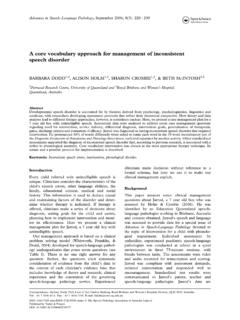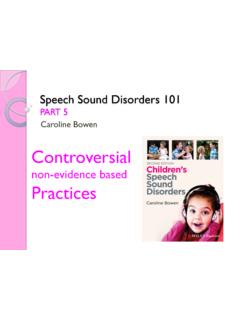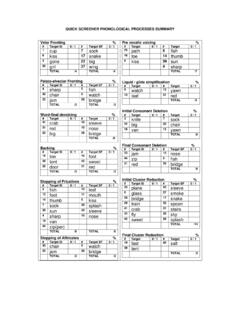Transcription of Minimal Pair Approaches to Phonological Remediation
1 57 Updates in Phonological Intervention; Editors in Chief, Nancy Helm-Estabrooks, , and Nan Bernstein Ratner, ; Guest Editor, Shelley Velleman, in Speech and Language, volume 23, number 1, 2002. Address forcorrespondence and reprint requests: Jessica A. Barlow, , Department of Communicative Disorders, San DiegoState University, San Diego, CA 92182. E-mail: of Communicative Disorders, SanDiego State University, San Diego, California and 2 Department of Speech and Hearing Sciences, Indiana University,Bloomington, Indiana. Copyright 2002 by Thieme Medical Publishers, Inc., 333 Seventh Avenue, New York, NY10001, USA. Tel: +1(212) 584-4662. 0734 0478,p;2002,23;01,057,068,ftx,en; Pair Approaches to Phonological RemediationJessica A.
2 Barlow, ,1and Judith A. Gierut, article considers linguistic Approaches to Phonological reme-diation that emphasize the role of the phoneme in language. We discussthe structure and function of the phoneme by outlining procedures for de-termining contrastive properties of sound systems through evaluation ofminimal word pairs. We then illustrate how these may be applied to a casestudy of a child with Phonological delay. The relative effectiveness of treat-ment Approaches that facilitate phonemic acquisition by contrasting pairsof sounds in Minimal pairs is described. A hierarchy of Minimal pair treat-ment efficacy emerges, as based on the number of new sounds, the numberof featural differences, and the type of featural differences being intro-duced.
3 These variables are further applied to the case study, yielding a rangeof possible treatment recommendations that are predicted to vary in :Phoneme, Minimal pair, Phonological remediationLearning Outcomes:As a result of this activity, the reader will be able to (1) analyze and recognize the con-trastive function of phonemes in a Phonological system, (2) develop Minimal pair treatment programs that aimto introduce phonemic contrasts in a child s Phonological system, and (3) discriminate between different typesof Minimal pair treatment programs and their relative given our need to understand howlearning takes place in the course of interven-tion. Still other Approaches are grounded inlinguistics because the problem at hand in-volves the Phonological system.
4 In this article,we explore the linguistic bases of phonologicalModels of clinical treatment for childrenwith functional Phonological delays have beenbased on three general theoretical models are founded on developmentgiven that the population of concern involveschildren. Other models have their basis in58 SEMINARS IN SPEECH AND LANGUAGE/VOLUME 23, NUMBER 1 2002intervention with a specific focus on thephoneme. We ask three questions: What arethe structure and function of phonemes in lan-guage generally? How are phonemes assessedin children s sound systems? And, how mighttreatment be designed to best facilitate phone-mic acquisition?WHAT IS A PHONEME?For the linguist interested in the study ofphonology, a primary aim is to establish theinventory of sounds and how these function ina given language.
5 For the speech-languagepathologist, a key to establishing treatmentgoals is to assess the sounds of a child s phono-logical system. As with the linguist studying anewly discovered language or reanalyzing awell-known one, our clinical aim in analyzinga developing Phonological system is to deter-mine which sounds are used as phonemes by achild and which are used as allophones. Toevaluate this requires a firm understanding ofjust what a phonemeis. A phoneme reflects acertain ideal concept of a sound, according tothe perceptions of the speaker, even thoughthat phoneme might actually be producedphonetically in a variety of ways. Take thephoneme /t/, for example. As speakers of theEnglish language, we all share a similar con-cept of /t/.
6 This is reflected in our spelling aswell as our perceptions about the sounds in ourlanguage and in other languages. When wehear words such as tie, star, butter, and button, we, as English speakers, recognizethat all of these words have the sound /t/ incommon. This is the case despite the fact thatthe relevant sounds in these words are actuallyquite different from one another in produc-tion. Whereas tie is pronounced with an as-pirated [th] as [th ], star is pronounced withan unaspirated [t] as [st r]. Butter is pro-nounced with a flap in American English as[b ], and button is produced with a glottalstop as [b n ]. Nevertheless, speakers of theEnglish language assume that all four ofthese phones [t t ] belong to one and thesame category the phoneme /t/.
7 These fourphonetic variants then are allophonesof thephoneme /t/.By definition, phonemes are abstract, men-tal concepts of sounds that reflect a speaker sinternal or mental knowledge about the lan-guage he or she speaks, and they function tomark distinctions in meaning. Phonemic dis-tinctions are made most apparent in minimalpairs. A Minimal pairis a set of words that dif-fer by a single phoneme, whereby that differ-ence is enough to signal a change in instance, the words map [m p] and mat [m t] form a Minimal pair in English. Thesetwo words are identical in terms of the firstconsonant and the vowel. They differ only bythe last consonant [p] versus [t] and thisdifference signals a change in meaning ( map versus mat ).
8 English speakers would agreethat map and mat are two very differentwords with two very different meanings. The map mat example illustrates how minimalpairs reveal phonemic contrasts in final posi-tion, but contrasts also occur in other contexts,including word-initial position, such as map [m p]- cap [k p], as well as word-medialpositions, such as fashion [f n]- fasten [f s n]. Cluster contexts, both initial andfinal, can also be revealing of contrasts, as with spy [sp ]- sky [sk ] or cats [k ts] caps [k ps]. Vowels too contrast within min-imal pairs, as with map [m p] mop [m p]and cap [k p] keep [kip]. Finally,nearminimal pairsare found via cluster-singletoncomparisons, such as play [ple ] pay [pe ],or vowel- versus consonant-final comparisons,such as boat [bo t] bow [bo ].
9 In comparison with these examples ofphonemes revealed by Minimal pairs, we con-sider another possible pair in English, [m p]and [m p ]. These two forms are identical withrespect to the first consonant and the vowel aswith the map mat example. Similarly, theyalso differ only by the final sound: released [p]versus unreleased [p ]. However, most impor-tant, this phonetic difference does not signal achange in meaning because the two words meanexactly the same thing, map. With no differ-ence in meaning, [m p] and [m p ] do notform a Minimal pair. Consequently, [p] and [p ]are not contrastive, nor do they function asMINIMAL PAIR Approaches /BARLOW, GIERUT59phonemes in English; instead, they are allo-phones (phonetic variants) of the phoneme /p/.
10 Phonemes are typically viewed as phoneticreflexes of a complex of smaller sized unitsknown as distinctive features. Consequently, it isnot the phonemes per se that are the contrastiveelements of a language; rather, it is their featuralmakeup. The features that contrast serve to cre-ate an opposition between phonemes of a par-ticular ,2 Phonemes may contrast withone another along one or more of a number ofspecific feature dimensions. In formalized lin-guistic frameworks, these featural contrasts aredescribed in terms of distinctive features as de-scribed in, for example,The Sound Pattern can be interpreted in perhapsmore familiar terminology associated withplace, manner, and voice for the present pur-pose, as illustrated for English phonemes inTable of articulation features differentiatelabial, coronal, and dorsal contrasts, which arerelevant to the phonemic distinctions among/p t k/ and /b d / in, for example, pea, tea, and key or by, dye, and guy, of articulation features differentiate[continuant] contrasts, which are relevant todistinctions between stops, fricatives, and af-fricates.














